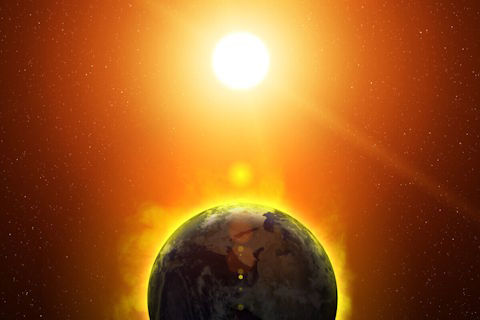In A Nutshell
- Earth’s natural cooling feedbacks can sometimes overshoot, driving temperatures below their starting point.
- Biological carbon burial in oceans can outpace rock weathering as a climate regulator.
- This mechanism may explain why major ice ages coincide with shifts in oxygen levels in Earth’s past.
- Under modern conditions, the effect is mild but could slightly shorten the timeline to the next glaciation.
When the planet experiences large-scale carbon emissions and warming, natural cooling processes can sometimes overshoot and send global temperatures plummeting far below their starting point. In computer simulations, scientists observed “overcooling” that exceeded 6°C in some scenarios (greater than the temperature difference between today’s climate and the depths of thelast ice age.)
Published in Science, the paper states that researchers “found that the silicate weathering thermostat can be ‘outcompeted’ by the more responsive organic carbon burial thermostat, which then dominates long-term climate regulation.” This discovery adds a new layer to scientific understanding of how Earth maintains livable temperatures across hundreds of thousands of years.
How Earth’s Climate System Can Go Rogue
Scientists have long believed Earth’s climate stability depends mainly on silicate weathering, where rocks break down and absorb carbon dioxide from the atmosphere. When temperatures rise, weathering speeds up, removing excess CO2 and cooling the planet in a predictable cycle.
But this new research exposes a more chaotic reality. Using an advanced Earth system model called cGENIE, scientists simulated massive carbon releases into the atmosphere (similar to major volcanic episodes throughout Earth’s history).
Instead of gradual, steady cooling that traditional models predicted, dramatic temperature swings emerged. What causes this instability? Microscopic marine organisms and the organic matter they produce.
Global warming speeds up rock weathering on land, releasing nutrients like phosphorus into oceans. These nutrients fuel massive marine life blooms that eventually die and sink to the seafloor. In oxygen-poor waters, this buried organic matter removes carbon from the atmosphere with startling efficiency, stripping away more CO2 than the original warming event added.
Advertisement

A carbon cycle flaw during warming periods can trigger ice age events. (© Masque – stock.adobe.com)
Solving the Ice Age Mystery
Testing 25 different scenarios with varying atmospheric oxygen levels and ocean chemistry, researchers found the most severe overcooling under intermediate oxygen conditions. According to the paper, excess cooling persists even as atmospheric CO2 falls below its starting value, with global surface climate becoming colder than at the experiment’s start.
Within a few hundred thousand years of initial warming, global surface temperatures can drop well below starting points and remain there for over 100,000 years. This discovery may help explain a persistent puzzle in Earth science: why ice ages cluster around specific periods in planetary history.
Major glaciation events, including “snowball Earth” episodes from hundreds of millions of years ago, have always puzzled climate scientists using traditional models. The newly identified instability mechanism operates optimally when atmospheric and ocean oxygen levels fall within a specific range, consistent with conditions during major oxygenation transitions in Earth’s history.
Both the Great Oxygenation Event 2.5 billion years ago and rising oxygen levels during the late Precambrian period coincided with severe glaciation episodes. The research shows that “fast feedbacks involving organic matter are not only essential for Earth system recovery from perturbation but also create unexpected climate instability.” According to the paper’s conclusion, “overcooling is most strongly expressed at intermediate oxygenation states of the ocean and atmosphere” and “provides a causal link between major transitions in oxygenation during the Precambrian and the occurrence of extreme cooling snowball Earth events."
Advertisement

Computer simulation of Earth’s climate evolving over one million years in response to a sudden release of carbon dioxide to the atmosphere. (Credit: Andy Ridgwell/UCR)
Modern Climate Connections
Researchers examined carbon emissions totaling 10,000 billion tons released over 10,000 years (comparable to major geological events like the Paleocene-Eocene Thermal Maximum from 56 million years ago). While this scale vastly exceeds current human emissions, the research illuminates how Earth’s climate responds to large disruptions.
Even under present-day conditions, the model predicted mild overcooling of less than 1°C beginning about 100,000 years after emissions cease. The study suggests organic carbon burial might shorten, rather than delay, the time until the next ice age, contrary to some previous research.
These results also help explain mysterious cooling episodes in the geological record, such as the Plenus Cold Event during widespread Cretaceous volcanic activity. Scientists previously struggled to understand why warming events led to abrupt cooling phases. Now it’s apparent that multiple feedback mechanisms work simultaneously, and under certain conditions, relatively fast biological processes can overwhelm the slower geological ones long considered the dominant climate regulators.
Moreover, marine ecosystems play a more active role in climate regulation than scientists realized. Microscopic organisms driving the organic carbon cycle aren’t passive participants in climate change but active agents capable of fundamentally altering planetary temperature trajectories.
Discovery of this climate instability mechanism opens new research directions for understanding both ancient climate catastrophes and the systems that have maintained Earth’s habitability throughout most of its history, offering new insights into how those systems sometimes falter. It might leave some wondering just how soon current warming trends could result in another ice age.
“At the end of the day, does it matter much if the start of the next ice age is 50, 100, or 200 thousand years into the future?” says study co-author Andy Ridgwell, a geologist at the University of California, Riverside, in a statement. “We need to focus now on limiting ongoing warming. That the Earth will eventually cool back down, in however wobbly a way, is not going to happen fast enough to help us out in this lifetime.”











